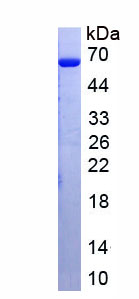Active Stem Cell Factor Receptor (SCFR)
CD117; KIT; C-Kit; PBT; p145 c-Kit; C-Kit Receptor; Tyrosine-Protein Kinase; V-Kit Hardy-Zuckerman 4 Feline Sarcoma Viral Oncogene Homolog; Piebald Trait
- Product No.APA121Hu61
- Organism SpeciesHomo sapiens (Human) Same name, Different species.
- Buffer FormulationPBS, pH7.4, containing 5% Trehalose.
- Traits Freeze-dried powder
- Purity> 90%
- Isoelectric Point6.4
- ApplicationsCell culture; Activity Assays.
- DownloadInstruction Manual
- UOM 10µg50µg 200µg 1mg 5mg
- FOB
US$ 226
US$ 564
US$ 1128
US$ 3384
US$ 8460
For more details, please contact local distributors!
ACTIVITY TEST

Stem Cell Factor Receptor (SCFR), also known as c-Kit and CD117, is a widely expressed 145 kDa receptor tyrosine kinase. Binding of SCF R to SCF promotes the survival, differentiation, and mobilization of progenitor cells in multiple lineages. Mature human SCFR consists of a 499 amino acid (aa) extracellular domain (ECD) with five tandem immunoglobulin-like domains, a 21 aa transmembrane segment, and a 431 aa cytoplasmic domain with the split tyrosine kinase domain. SCFR is up-regulated on dendritic cells by Th2- or Th17-biasing stimuli, and it is required for subsequent dendritic cell induction of Th2 and Th17 responses. Besides, Epidermal Growth Factor (EGF) has been identified as an interactor of SCFR, thus a functional binding ELISA assay was conducted to detect the interaction of recombinant human SCFR and recombinant rat EGF. Briefly, biotin-linked SCFR were diluted serially in PBS, with 0.01% BSA (pH 7.4). Duplicate samples of 100 ul were then transferred to EGF-coated microtiter wells and incubated for 1h at 37℃. Wells were washed with PBST 3 times and incubation with Streptavidin-HRP for 30min, then wells were aspirated and washed 5 times. With the addition of substrate solution, wells were incubated 15-25 minutes at 37℃. Finally, add 50 µl stop solution to the wells and read at 450 nm immediately. The binding activity of recombinant human SCFR and recombinant rat EGF was shown in Figure 1, the EC50 for this effect is 0.09 ug/mL.
USAGE
Reconstitute in 10mM PBS (pH7.4) to a concentration of 0.1-1.0 mg/mL. Do not vortex.
STORAGE
Avoid repeated freeze/thaw cycles. Store at 2-8°C for one month. Aliquot and store at -80°C for 12 months.
STABILITY
The thermal stability is described by the loss rate. The loss rate was determined by accelerated thermal degradation test, that is, incubate the protein at 37°C for 48h, and no obvious degradation and precipitation were observed. The loss rate is less than 5% within the expiration date under appropriate storage condition.
GIVEAWAYS
INCREMENT SERVICES
-
 BCA Protein Quantification Kit
BCA Protein Quantification Kit
-
 Molecular Mass Marker for Protein
Molecular Mass Marker for Protein
-
 Monoclonal Antibody Customized Service
Monoclonal Antibody Customized Service
-
 Polyclonal Antibody Customized Service
Polyclonal Antibody Customized Service
-
 Protein Activity Test Experiment Service
Protein Activity Test Experiment Service
-
 Electrophoretic Mobility Shift Assay (EMSA) Experiment Service
Electrophoretic Mobility Shift Assay (EMSA) Experiment Service
-
 Buffer
Buffer
-
 Lentivirus Packaging Experiment Service
Lentivirus Packaging Experiment Service
-
 Adenovirus Packaging Experiment Service
Adenovirus Packaging Experiment Service
-
 Real Time PCR Experimental Service
Real Time PCR Experimental Service
-
 Spike RBD Protein (S-RBD)
Spike RBD Protein (S-RBD)
-
 Protein G
Protein G
-
 Protein A
Protein A
| Magazine | Citations |
| Chemico-Biological Interactions | Protective effects of honokiol against methylglyoxal-induced osteoblast damage PubMed: 26723916 |







